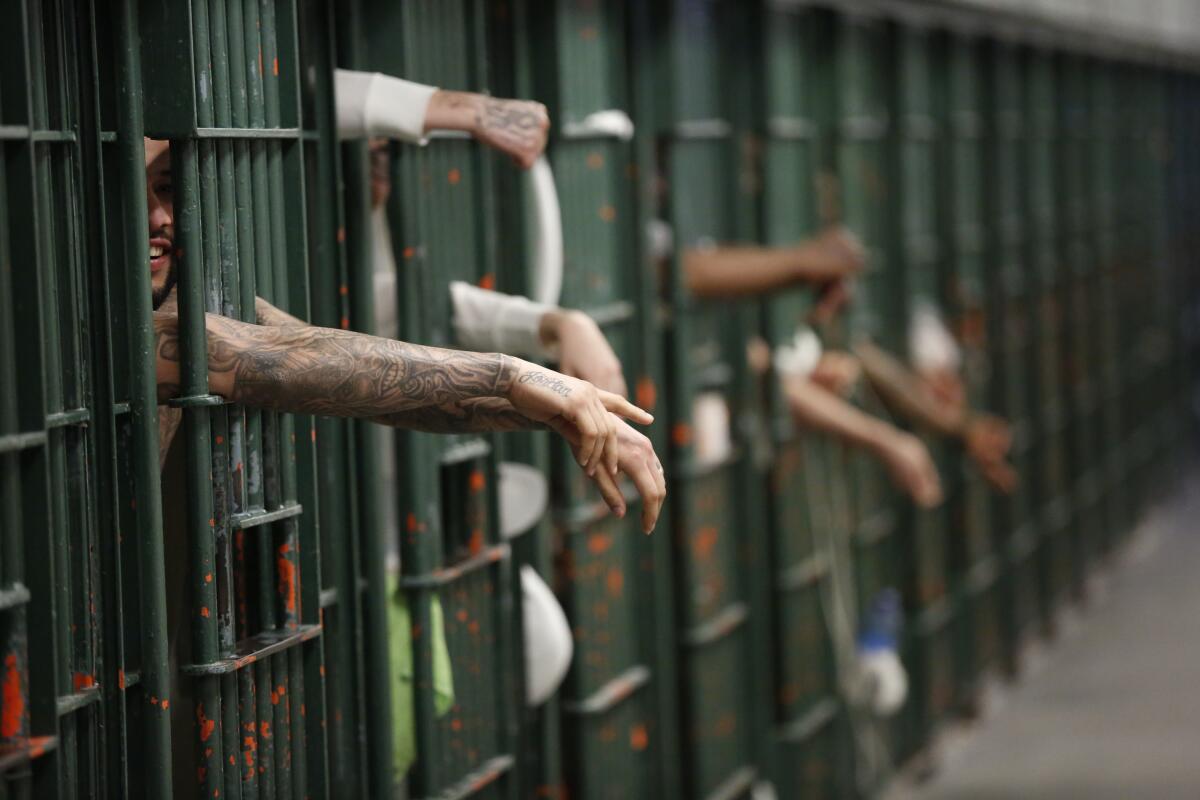Editorial: Start the demolition countdown at Men’s Central Jail

- Share via
It’s time to get the wrecking ball ready for Los Angeles County’s dungeon, also known as Men’s Central Jail. It’s a decrepit and dangerous place that generally leaves people in even worse shape on their way out than they were on their way in. County officials, prodded by thoughtful input from and relentless activism by health and justice advocates, have already acknowledged that the 58-year-old building needs to come down and be replaced — not with a new jail or a mental hospital, but with a decentralized network of care and services aimed at prevention, treatment and safe reintegration into communities.
The only remaining question is when to start the demolition countdown. And the answer should be “now.”
It has been an extraordinary journey from a decade ago, when the Board of Supervisors squabbled over whether to replace the aging, 5,640-bed jail with something bigger (and if so, how much bigger) or something smaller. There was a tacit acknowledgment that whatever size the jail was, we’d find a way to fill it — but no agreement as to whether filling a jail is a good thing. After all, don’t you need someplace to put all the criminals?
Yet so much of the jail was filled with people who had not been convicted of any crime, but instead were locked up only because they couldn’t pay bail or couldn’t assist in their own defense. Or people who had been convicted of crimes, but only because the dearth of psychiatric assistance or substance-use treatment, or the lack of affordable housing or crisis assistance, left too many at their wits’ end and acting in desperation or illness.
Besides, there remains sufficient capacity in the county’s other jails.
There was a steady argument from reformers who, sounding at first like utopian dreamers, called for no new jail at all. Their advocacy and their argument finally persuaded the supervisors to adopt a care-first, jail-last approach.
For any L.A. resident wondering what we’re to do with all those people who otherwise would be jailed, and how we’re going to pay for the services and facilities called for in the county’s Alternatives to Incarceration plan, there are a few things to remember.
For example, the cruelty and chaos of the pandemic have helped the case for closing the jail. The need to stem the spread of COVID-19 meant quickly reducing the inmate population, and the courts and the sheriff did it swiftly and successfully with no harm to public safety (the nationwide increase in violent crime, preliminary studies suggest, was unrelated to jail releases or reduced admissions), proving the viability of jailing fewer people. Granting pretrial release to everyone accused of nonviolent crimes was largely safe and successful.
The George Floyd killing and the resulting protests and unrest drove home the need for racial accounting and improvement in the criminal justice system. Los Angeles County residents responded in November by passing Measure J, which will help fund some of the care-first program, and by electing Dist. Atty. George Gascón, whose policies seek to use incarceration only for those for whom there is no better alternative.
The Biden administration and Congress have provided federal funding at levels undreamed of a year ago, and much of it can be tapped for justice reforms.
In striking down the use of cash bail that defendants can’t afford, the state Supreme Court in the recent Humphrey ruling essentially directs the further reduction of the jail population by declaring that anyone currently there for lack of money should be released. And remember, jail is not prison: Anyone sentenced to serve time there will be leaving in a matter of weeks or months, and isn’t it safer for the rest of us and better for them if they enter a program that has a better record of improving behavior than the jail has?
Tension continues to accompany discussions between county officials on one side and community advocates and service providers on the other, yet they are still working together in a way never before seen on such a sweeping enterprise.
We are witnessing a rare harmonic convergence of propitious events and social movements, but it won’t last forever. There will never be more public backing, more funding sources, more momentum than at this moment.
Yes, the care-first program has to work, so it makes sense to get the bugs out. But the program can’t remain in the study phase forever. As long as the jail remains we will find a way to fill it. It’s time for the supervisors to prioritize closing the jail and accelerating the care-first infrastructure, and to instruct county staff to allocate funding accordingly. And to get the wrecking ball ready, and start the countdown.
More to Read
A cure for the common opinion
Get thought-provoking perspectives with our weekly newsletter.
You may occasionally receive promotional content from the Los Angeles Times.










